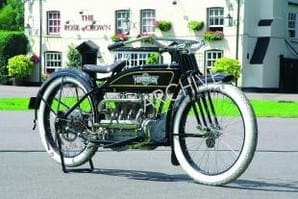
Second instalment of Rod Gibson's Kawasaki Z1 engine rebuild. Captions are reproduced in full below but for step-by-step captions and images, visit the image gallery.
Image gallery captions
Picture one: Last month I left the engine in big lumps, now it’s time to dismantle all the component parts for a through health check. I'm starting with the cylinder head, and using a valve spring compressor to remove all the valves, one at a time. Each valve is retained with split cotters, and I'm storing the valves with their original springs, collars and cam followers in the order they were fitted in the head.
Picture two: Carbon build up on the valves isn't too bad, and these will all clean up with a little time spent on a rotary wire brush. The other crucial area on the valves is the integrity of the sealing face – you may be able to make out a little light pitting on this exhaust valve. This is the worst example of the eight, and a little time spent with grinding paste should restore it to mint condition.
Picture three: Carbon build-up in the combustion chambers is light too, and responds well to a little work with some fine steel wool and Solvol Autosol. It's still an evening’s work to clean up all four combustion chambers and their related inlet and exhaust ports, but rushing the job with power tools could score or mark the soft alloy surfaces of the cylinder head. This engine was burning oil, and it's interesting to note from Dave Marsden’s excellent reference book on Z1s that very early models were fitted with phosphor bronze valve guides, upgraded to cast iron shortly into the production run to cure oil burning problems. Sure enough, this head has phosphor bronze guides fitted.
Picture four: With the combustion chambers cleaned up, I can closely examine the valve seats for signs of pitting. Again, these look pretty good, and a light skim over with grinding paste should suffice to bring them back to factory specs. I'll be lapping them in after the head has received specialist attention, to make sure they're perfectly radial to any new valve guides we have to fit. If badly pitted, valve seats can be re-cut; but be wary of removing too much metal on a dohc engine like this one, as you could end up having problems with shim sizes for valve clearances later.
Picture five: Also on the cylinder head, I'm taking a close look at the cam bearing shells. This first generation dohc Kawasaki has replaceable shells, which many consider an advantage over later designs which had the cam journals running directly in a machined alloy surface. Provided there's been no problem with lubrication the later type is fine, and as I always feel duty bound to replace shell bearings with a new set during a rebuild you could even consider this Z1 set-up as unnecessarily costly. The cam bearing caps, incidentally, are machined at the factory as a set with the cylinder
Picture six: With the head checked out and pronounced basically sound, it’s time to get some serious reconditioning sorted. Fast forward several weeks, and the crankcases, head, cambox and barrels have been up to Triple S in sunny Bingley for blasting and powder coating. The resulting satin black finish is far superior to anything offered by the factory and should stay smart and durable more or less indefinitely. Once the head has been coated, it’s off to Serco Engineering to get the valve guides measured. head, which explains why you can't buy them separately as spare parts. It also explains why they have to be replaced in the right order, and the right way round.
Picture seven: Serco also measure the cylinder bores. Verdict? All four bores are on the edge of specifications, and the valve guides are worn out. We opt for a rebore with new pistons, and upgrading to the later spec cast iron valve guides. The top end components take their place in the queue at Serco, and I'm off back down the motorway to Lincolnshire where I can pay some attention to the engine’s bottom end in the meantime.
Picture eight: Offloading all the parts at the Mechanics workshop, I can't help spending a few minutes admiring the superb powder coating job Triple S have carried out on the crankcases. I washed and degreased the cases before sending them off, but Andy at Triple S has painstakingly masked off each drilling and mating surface before blasting and coating the cases. This is an enormously time-consuming process, and obviously isn't quick or cheap to do. But with a bike as rare and special as this one it’s a worthwhile investment, and it’s a far superior finish to any amount of scrubbing up and spraying with engine enamel.
Picture nine: The clutch basket is notorious on big Jap fours for developing play at the shock absorber, allowing the clutch to wobble back and forth on its springs and, in extreme cases, emit hideous screeching sounds as it takes up the drive on drag starts. Sure enough, this one has a little bit of play in the springs, but a low mileage and gentle life mean it’s fairly minimal, and doesn't justify the cost of replacing the whole basket assembly. While it's possible in theory to drill out the rivets and fit reconditioned parts, the factory don't supply the bits to do the job, and tracking them down can feel like the search for the holy grail.
Picture 10: And, if there’s any such thing, this is the ‘Achilles’ Heel’ of the Z1 engine design. The one place Kawasaki opted to use a slipper blade instead of a sprocket roller on the camchain run is this little fellow, hidden at the front of the barrels and located with a single pan-head screw. It's too small to do the job, and arguably fitted at the wrong angle too, so heavy wear is the norm and replacement is essential at every top end strip. I've seen these slipper blades wear right through and break up in service, with disastrous consequences. Don't have nightmares, but do remember to fit a new blade if you have your 900 or 1000 engine is stripped for any reason.
Picture 11: To get the crankcases into the powder-coating booth, Triple S had to remove the cylinder studs I'd inadvertently left in place. Andy is a patient man and didn’t tell me off too badly, but you can help him out by removing things like this if taking work in for coating. I've used a tap to clean out traces of old Loctite before winding the studs back in, using two nuts locked together to get a purchase on each stud. A spot of Loctite blue on each stud will make sure it stays put. The studs are different lengths, too, but fortunately I have an old Z900A4 factory parts list which helpfully shows which stud goes where.
Picture 12: Of course, no engine rebuild would be complete without attention to the fasteners. For originality, many would choose to re-plate the original screws and bolts. I still tend toward rebuilding for long term good looks and durability rather than a concours finish, so I've opted for a set of stainless bolts from the ever helpful Inox Fasteners for the rebuild. These will look good forever. For the outer crankcase screws, however, I've opted to use 6mm pan-head screws as originally fitted. This engine already had a number of new-ish screws fitted, so I've sourced a few new ones to make up a full set. A good compromise between looks, durability and originality, I hope!
Picture 13: The starter clutch is not immune from trouble on any big Jap four, so it always warrants careful attention. Bolted to the back of the generator rotor, the main starter clutch body houses three rollers, each fitted into a wedge-shaped housing and spring loaded with a tiny plunger and spring. These rollers are wedged against the drive boss when the clutch turns in one direction, but back off to a freewheel position when it’s rotated the other way. The plungers and springs must be in good condition, but don't neglect the rollers too. Any signs of wear will show as flatting on the drive surfaces; now is the time to replace them if in doubt.
Picture 14: Still with the starter clutch, this is the boss on the drive gear that the three rollers engage with. Again, any signs of flatting here means the drive gear will have to be replaced, or the clutch will slip under load, resulting in a frustrating freewheeling clutch when you press the starter button. This one is more or less mint, confirming the bike’s low mileage. Servicing the starter clutch isn't too big a job on bikes like the Z1, but beware of middleweight designs like the Z650 or Honda 400/4 which have their starter clutches hidden deep inside the engine.
Picture 15: After something of a wait as endless rows of Triumph Tiger Cubs are prepared by Serco for the upcoming pre-65 trials season, our Z1 head and barrels are ready at last. Martyn has ordered a new set of pistons and rings, bored the barrels to suit, and supplied and fitted new valve guides. The bad news is that all this work has cost a monstrous £922.23, which would move the cost of the rebuild into untenable territory were the bike not so rare and its (anonymous) owner so well heeled. With a wait of over three months for the job, I'm afraid it’s time to look for more cost effective solutions for future engine work. The rings are marked on the top face to make sure they're fitted right way up on the new pistons.
Picture 16: At last, with the cylinder head powder coated and new valve guides fitted, I can lap in the valves to their respective seats. It only needs a light skim with coarse grinding paste to restore a good working surface to each valve, and a finishing spin with fine paste gives a lovely unbroken matt grey finish to the sealing area.
Picture 17: I've used the old ‘rubber sucker on a stick’ technique for this job which, despite the fairly light work required, still consumes a full evening. I took the precaution of labelling each valve when I stripped the head, so they can now go back in their original places. The Kawasaki cylinder head responds well to this lapping technique, though I have found some heads have valve seats too hard to succumb to such gentle attention. My old Z1000ST refused to give up even the tiniest burned-in pit to a valve seat after hours of tortuous stick spinning, and had to be sent away for its seats re-cutting with all the subsequent brinksmanship with shim sizes. I had thought this difference in seat materials was simply due to leaded and unleaded spec heads, but I'm told other factors of metallurgy are at work.
Picture 18: Each valve guide has a rubber seal fitted at its upper end to stop oil penetrating down the valve stem and burning on the over-run. These seals can harden with age and lose their sealing qualities, so should be replaced each time the valves are out of the head. Incidentally, the valve springs on the Z1 sit on top of dished steel collars which sit over the valve guide, and keep the springs separated from the soft alloy of the head. These lower collars must be in place before you fit the stem seals, as they won't fit over the seals later, and pulling a seal off will destroy it. A drop of ACF50 on each stem seal helps ease it over the ridge on the guide.
Picture 19: With a valve offered into the head, the springs drop over the guide, followed by the top collar and two split collets to hold it all together. To compress the valve spring far enough to fit the collets I'm using my ancient valve spring compressor, modified years ago to fit dohc heads by having two strips of mild steel welded onto the top jaws. I still use it for nostalgic reasons (how sad is that?); you may wish to use something a little more modern! A blob of grease on each valve stem holds the collets in place while I unscrew the compressor and repeat for the next valve.
Picture 20: The cam followers on this dohc engine take the form of a hollow cylinder, closed at the top end. When the engine was first launched, some wag decided these looked like inverted buckets and the term has stuck. It’s a very stable design, with any sideways loads being transferred over the large radius of the follower and consequent low rates of wear on the valve gear. The recess on top of each bucket accepts a shim, supplied in a range of thicknesses to permit correct setting of the valve clearances. As these valves have all been lapped in I'll have to shim it from scratch; a job which will have to wait until the engine is fully assembled. For the time being I've refitted the original shims where they were, having first noted their sizes and positions. This will hopefully give me a starting point to work from later.
Picture 21: Last job on the cylinder head is this drive gear assembly for the rev counter. A little grease on its new O-ring makes sure it presses in easily, and the whole assembly is retained with a small catch plate held in with a single screw. The skew gear on the tacho drive is driven from a matching worm gear on the exhaust cam, a dead giveaway if you managed to mix up the exhaust and inlet cams in the box of bits. But remember later models had electronic tachos, so you can't depend on this method on all twin-cam bikes.
Picture 22: I've had all the outer engine covers polished by M&G of Halifax, who have done their usual cracking job. To follow the original finish, M&G have also polished the outer corners of the freshly powder coated cam cover, which took a little co-ordination between them and Triple S to make sure they didn't have to remove a diamond hard layer of powder coating first. This kind of attention to detail makes their services special, and will keep me coming back in years to come. I've carefully unwrapped the alternator stator from its bubble-wrap cocoon, and can now bolt it back in to the cover, with a little Loctite on each screw thread.
Picture 23: I can now begin to think about starting to rebuild the engine. Before joining the crankcases, there's a little preparatory work to do. The gear selector drum fits into the lower crankcase half, the input shaft selector fork held captive on it by its lockbolt and tab washer. The two selector forks for the output shaft gears run on their own dedicated spindle which presses in from the left side of the casing, and butts up to the case against its circlip. I've marked these two selector forks to make sure they go in the same way they came out, but I've a sneaking suspicion they're interchangeable. I'd rather not risk it unless I'm sure, as a problem with the selectors could involve another crankcase split later on to correct the fault.
Picture 24: Next, I'm positioning the crank assembly into the upper crankcase half and re-fitting the centre main bearing cap. Of course, the essential thing here is to remember to fit the new camchain over the crank before fitting it. Personally I've always had an irrational aversion to soft link camchains, preferring to fit an endless chain of the type favoured by the factories.
Picture 25: The input shaft also drops into the top crankcase half at this point, and it's important to make sure the half moon locating rings are in place to locate the gearbox bearings. Unlike most Jap fours, it’s also vital to fit the clutch basket to the input shaft at this stage as there is not enough room to fit it through the clutch case aperture later on. Note how the primary drive gears mesh between the crank web and clutch basket.












